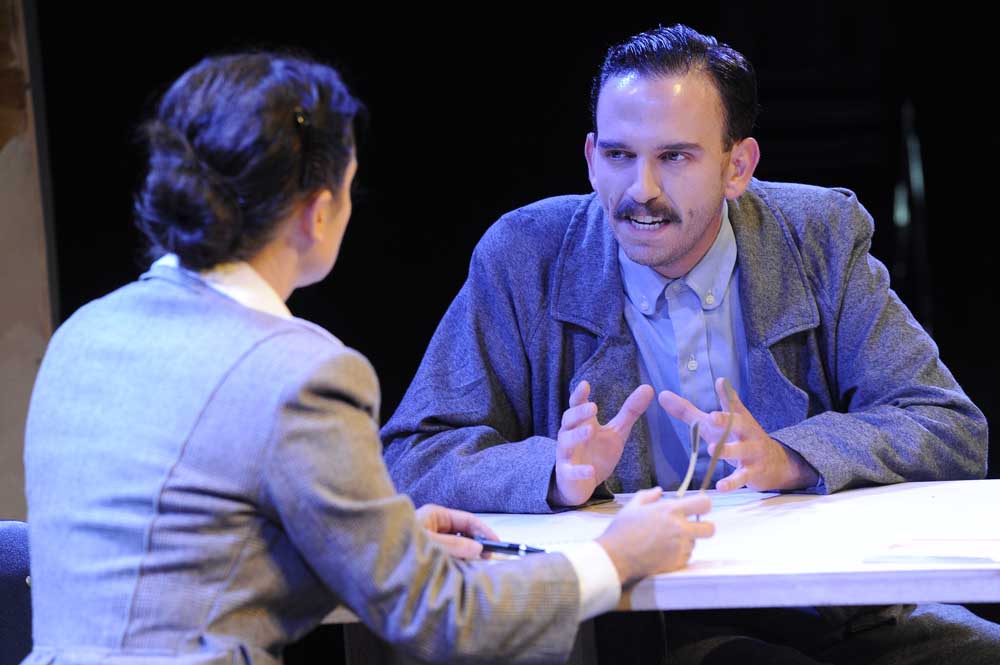‘Under a Red Moon’ rises at 2nd Street
Published 12:00 am Thursday, August 30, 2018

- Joshua Curtis and Kelley Dolan Ryan rehearse a scene from "Under a Red Moon" at 2nd Street Theater on Wednesday, Aug. 22, 2018. (Ryan Brennecke/Bulletin photo)
The true story of British serial killer John George Haigh — or as the press called him, the Acid Bath Murderer — serves as the basis of the psychological thriller “Under a Red Moon.” The Michael Slade play opens Friday at 2nd Street Theater in Bend.
Set in the late 1940s in the wake of World War II, the play opens with psychiatrist Dr. Ruth Covington (played by Kelley Dolan Ryan) arriving at a jail to interview Haigh (Joshua Curtis), after he’s confessed to killing multiple people. There’s only one other character, the jailer (John Giambalvo), who is clearly no fan of Haigh. When Covington asks for water at the opening, he says he can bring her one but will have to remove it before Haigh arrives.
“We don’t want either of you getting sliced up,” he tells her. “Personally, I think we ought to give the bastard every opportunity to slit his wrists.”
At the same time, he doesn’t believe Haigh would actually harm himself: “He’s not that desperate yet.” A moment later, Giambalvo tells her, “What I think doesn’t matter.”
“Precisely,” she replies.
Haigh is attempting to plead insanity, and so it falls on Covington to determine whether or not he’s sane. Charming, clever and intelligent, Haigh knows that if he’s found insane, he’ll live out his days in a psychiatric hospital.
And like that, the cat and mouse game begin. Ryan and Curtis sink their collective teeth into the demanding roles as they spar. At times it seems as though Haigh is interviewing Covington as he attempts to get inside her mind. Ever the consummate pro, she gives as good as she gets, answering his questions with questions of her own.
“He was a felon,” director Juliah Rae said of the real-life Haigh prior to a rehearsal at 2nd Street. “He went to prison three times for forgery, and he was really good at forging. Then he discovered that killing was even easier.”
Why was he known as the Acid Bath Murderer? She knows that, too.
“Because he disposed of the bodies in sulphuric acid, assuming no body, no crime. And then he would write letters to the solicitor in their name, or to their relatives, and just got their property and lived high on the hog — until the money ran out,” she said. “And then lo and behold, another murder happened, or another disappearance happened.”
Haigh discusses with Covington his upbringing in a stiflingly conservative religious household, where friends were forbidden and even the radio was deemed an instrument of evil.
His father was “marked by Satan,” and his mother was “chosen by God,” he tells Covington. His strangely vivid recurring dreams play critical roles in his life and the plot of the play. Is he being truthful? As Slade wrote in a special note for the program, his play “asks the question, ‘What is sanity?’ as it explores the nature of evil and of faith.”
Slade did make some changes for the sake of the play.
“Michael turned the psychiatrists into a female,” she said. “There were psychiatrists who did interview him to determine his sanity. They decided he was (sane). His defender was trying to prove that he was not sane, but he wasn’t as clever as he thought he was.”
If Slade’s name rings a bell, it should. Over the years, the Bend theater has staged five previous Slade plays: the one-acts “Thanksgiving,” “Christmas” and “New Year’s Eve” (from a collection titled “Home for the Holidays”), along with the full-length “Garden Politics” — all directed by Rae — as well as “And a Child Shall Lead.”
The Bend theater occupies “a special place in my heart,” Slade writes in his program note. “Juliah Rae and I have a wonderful, ongoing director/playwright relationship.”
That relationship takes another step forward with “Under a Red Moon,” which exacted something of a toll on the playwright as he created it. Whenever he’s writing a play, the “characters inhabit my mind,” Slade writes. “I kind of channel them, and they talk to me.”
With “Under a Red Moon,” “after writing certain speeches, I needed to walk away from the computer and head out into the sunlight … because whatever I was tapping into to find the serial killer’s words … I needed to get away from it for a bit.”







